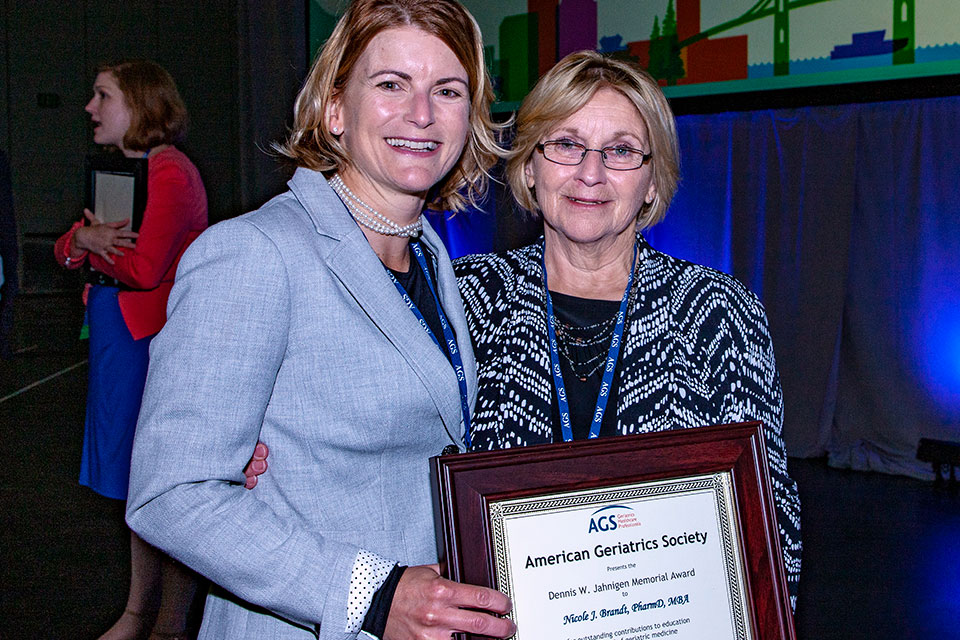New Guide Helps Clinicians Optimize Medication Management During COVID-19 Pandemic
Guide published by the Peter Lamy Center on Drug Therapy and Aging and US Deprescribing Research Network offers recommendations to improve resident-centered health and reduce opportunities for transmission of COVID-19 in post-acute and long-term care facilities.

By Malissa Carroll
April 30, 2020
The Peter Lamy Center on Drug Therapy and Aging at the University of Maryland School of Pharmacy and the US Deprescribing Research Network have published a new guide aimed at improving medication management for residents in post-acute and long-term care settings, including rehabilitation facilities and nursing homes, during the COVID-19 pandemic. Titled “Optimizing Medication Management During the COVID-19 Pandemic: Implementation Guide for Post-Acute and Long-Term Care,” the guide is available both in print and online.
“During these challenging times, it is critical that clinicians, particularly in post-acute and long-term care facilities, continue to evaluate their medication administration, management, and monitoring practices to ensure they meet the needs of each resident,” says Nicole Brandt, PharmD, MBA, BCGP, BCPP, FASCP, professor in the Department of Pharmacy Practice and Science (PPS) and executive director of the Lamy Center at the School of Pharmacy. “This guide will help health care professionals working in those facilities improve resident-centered health and well-being by offering guidance aimed at reducing the use of unnecessary medications, simplifying medication management, and reducing opportunities for transmission of COVID-19 between residents and staff.”
COVID-19 Outbreaks in Post-Acute and Long-Term Care Facilities
COVID-19 is the disease caused by the new coronavirus that emerged in China in December 2019. Its symptoms, such as cough, fever, shortness of breath, and loss of taste or smell can range from mild to severe, and have even resulted in death.
Because the virus easily spreads from person to person, post-acute and long-term care facilities are at high risk and have experienced some of the largest and deadliest outbreaks of the illness in the United States. An article published by The Baltimore Sun on April 28 notes that nursing home now account for more than half of deaths caused by COVID-19 in Maryland. At the time the article was published, there were 4,406 COVID-19 cases in Maryland nursing homes, with those facilities accounting for 471 of the state’s total 929 deaths. Administrators at these facilities have started to raise awareness about the need for more resources to help curb the spread of the virus among their residents and staff.
The guide developed by the Lamy Center and US Deprescribing Research Network focuses on medication issues related the COVID-19 pandemic, including the need to reduce the number of times health care professionals come into contact with patients to administer medications and reevaluate the use of nebulizers that can aerosolize viral particles and increase the risk of transmitting the virus. It can be used by health care professionals to complement other efforts currently in place at their facilities that aim to improve care quality and safety and infection control.
A Tool to Assist Clinicians in the Battle Against COVID-19
“Optimizing Medication Management During the COVID-19 Pandemic: Implementation Guide for Post-Acute and Long-Term Care” is divided into six sections: How to Use this Implementation Guide; Recommendations; Regulatory Considerations; Communication Around Medication Changes; Avoiding Unintended Consequences; and Additional Resources. Its content is derived from expert opinions compiled from 16 task force members whose expertise in geriatrics and long-term care span academia, non-profit organizations, and industry. It was also reviewed by outside experts and professional societies.
The recommendations included in the guide address medications that may be discontinued, reduced, or changed; changes to how medications are administered and monitored; appropriate alignment of medication administration times; and medication issues specific to COVID-19 and infection prevention. The guide also emphasizes the importance of communication around medication changes, providing a sample letter to prescribers and residents and their caregivers, and offers information that health care professionals can use to help avoid unintended consequences related to changes in a resident’s medication regimen. A dose conversion table is also included in the guide.
However, while the guide is intended as a resource for health care professionals in post-acute and long-term care facilities, the task force notes that it is important for users to remember that its recommendations are voluntary and advisory in nature, and should not substitute for clinical judgment. “We encourage health care professionals to review these recommendations together with an interdisciplinary care team to best determine which recommendations can be applied to their residents,” says Brandt. “All recommendations should be adapted to local circumstances and individualized to meet residents’ unique clinical situations and person-centered goals of care.”
To explore the online guide, as well as download a printer-friendly version of the guide for your facility, please visit the “Optimizing Medication Management During the COVID-19 Pandemic: Implementation Guide for Post-Acute and Long-Term Care” website.



